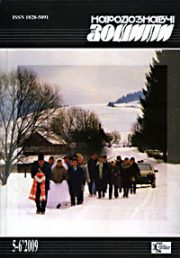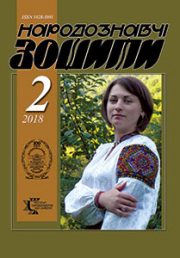The Ethnology Notebooks. 2017, 6 (138), 1521—1528
UDK 75.046(477)
DOI https://doi.org/10.15407/nz2017.06.1521
Received 24.10.2017
Osadcha Oleksndra Anatoliivna, Postgraduate student
at the Kharkiv State Academy of Design and Arts.
Mystetstv Street, 8, Kharkiv, 61002, Ukraine
Contacts: Tel. (057) 7062103; e-mail: academy@ksada.edu.ua
Abstract.The article is dedicated to the development of the religious theme in the Ukrainian art in context of the totalitarian culture. The influence of the avant-garde legacy on the visual language of the pieces, featuring Christian characters and motifs, is being considered. The range of works by masters from Kyiv and Odesa of the 1960s—1980s are analyzed to demonstrate the widespread of the expressionistic tendencies in the art of this period.
Keywords: Ukrainian art, second avant-garde, non-conformism, Christian theme, expressionism.
REFERENCES
Bychkov, V. (2006). Esteticheskij opyt Rossii na rubezhe tysjacheletij. In Estetika: vchera, segodnja, zavtra. (Vyp. 2, pp. 3—31). Moskva : IF RAN. [in Russian]
Holub, O. (2004). Utaiemnychenist’ svitu Mykoly Trehuba. Obrazotvorche mystetstvo,3, 70—71. [in Ukrainian]
Grojs, B. (1993). Utopija i obmen. Moskva : Znak. [in Russian]
Zaplotyns’ka, O. (2006). Nonkonformists’ka intelihentsiia v ofitsijnomu dyskursi 1960 rr.: mekhanizm formuvannia hromads’koi dumky. In Intelihentsiia i vlada (Vol. 6, pp. 58—66). [in Ukrainian]
Kassirer, E. (1999). Tehnika sovremennyh politicheskih mifov. In Politologija : hrestomatija (pp. 579—588). Moskva : Gardariki. [in Russian].
Kotova, O. (2007). “Projavlenie” v Odesse Vladimira Naumca. In F.D. Kohriht, E.M. Golubovskij & O.I. Gubar’ (Eds.), Deribasovskaja-Rishel’evskaja: Odesskij al’manah (Vol. 28, pp. 230 — 233). Odessa : Pechatnyj dom. [in Russian].
Kotova, O. (2014). Nonkonformists’kyj rukh u svitovomu kul’turnomu konteksti. Bulletin of Kharkiv State Academy of Design and Arts, 1, 101 — 104. [in Ukrainian].
Kokhan, T. (2002). Ekspresionizm v konteksti vydovoi spetsyfiky mystetstva (Dr. arthist. diss. abstr.). Kyiv. [in Ukrainian]
Levit, S. (Ed.). (1998). Kul’turologija XX vek: Enciklopedija. Sankt-Peterburg : Universitetskaja kniga. [in Russian]
Mohylevs’kyj, V. (1994). Mova ikonopysu. Dyvoslovo, 9, 54 — 59. [in Ukrainian]
Rize, H. (1996). Nonkonformisty. Vtoroj russkij avangard. Kel’n : Wienand. [in Russian]
Sedel’nik, V. Religija i ekspressionizm. In Enciklopedicheskij slovar’ ekspressionizma (pp. 483—485). Moskva: Institut mirovoj literatury imeni A.M. Gor’kogo. [in Russian]
Sers, F. (2000). Totalitarizm i avangard. V preddverii zapredel’nogo. Moskva : ProgressTradicija. [in Russian]
Smyrna, L. (2010). Ikonohrafiia nonkonformizmu. In V.D. Sydorenko, I.D. Bezghin & H.I. Veselovs’ka (Eds.), Suchasni problemy khudozhn’oi osvity v Ukraini: Zb. naukovykh prats’ (Vol. 6, pp. 247—268). Kyiv : Muzychna Ukraina. [in Ukrainian]
Epshtejn, M.N. (1989). Iskusstvo avangarda i religioznoe soznanie. Novyj mir, 12, 222—235. [in Russian].
Jarinich, S. (2011). Drugaja vetv’ kievskogo andegraunda (Interv’ju s O. Bilous). Antikvar, 12, 105—107. [in Russian]
Hatvani, P. (1988). Versuchüber den Expressionismus. In A.A. Wallas (Ed.), Texte des Expressionismus: Der Beitragjüdischer Autorenzur österreichischen Avantgarde (pp. 9—12). Linz-Wien. [in German].
Heißenbuttel, H. (1982).Thesen zum Sprachgebrauch des deutschen Expressionismus. In H. Meixner & S. Vietta (Eds.), Expressionismus — sozialer Wandel und kunstlerische Erfahrung: Mannheimer Kolloquium (pp.42—43). Munchen : Wilhelm Fink. [in German]
Leonenko, N. (2012). Zapozdalyj nekrolog. ArtUkraine. Retrieved from http://artukraine.com.ua/a/zapozdalyy-nekrolog/#.WeDFC7puKL8 [in Russian]





